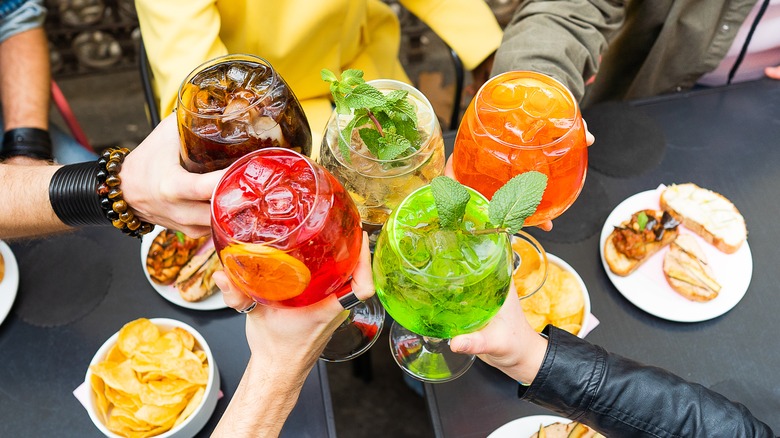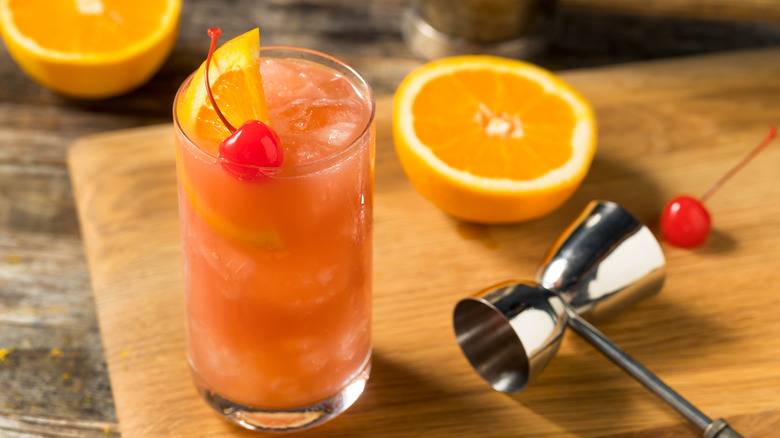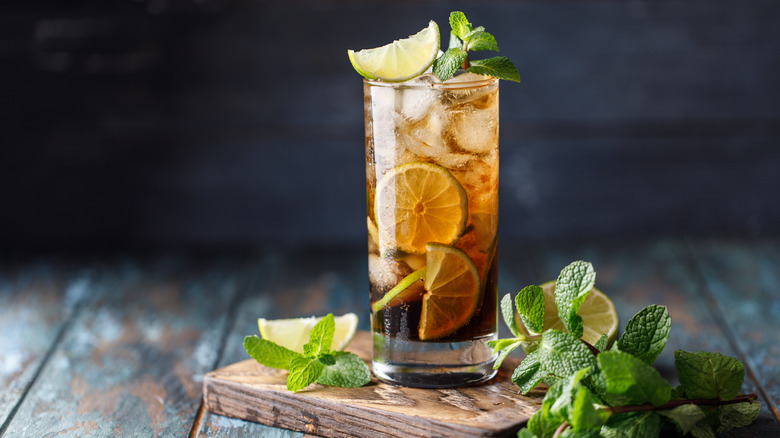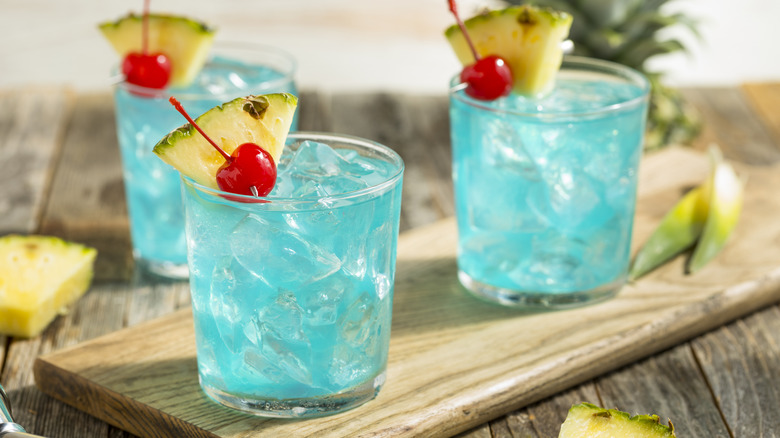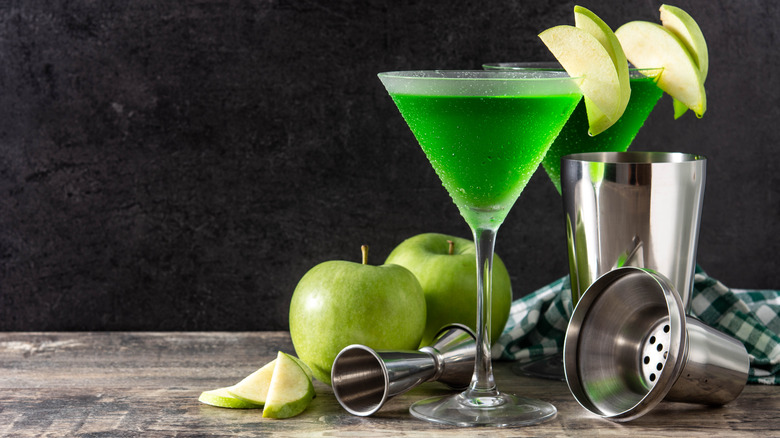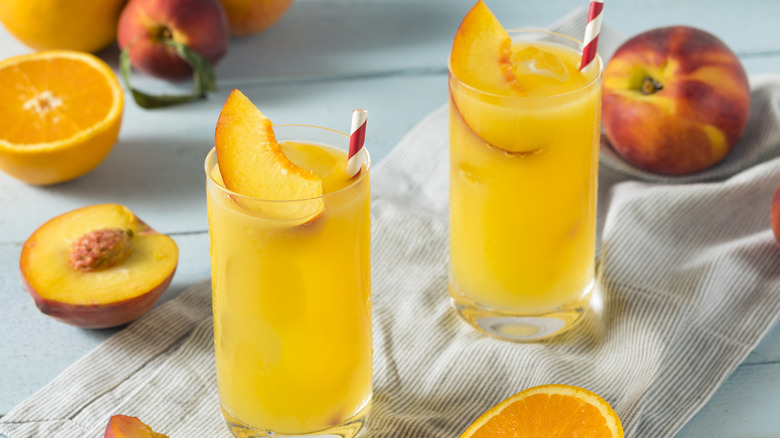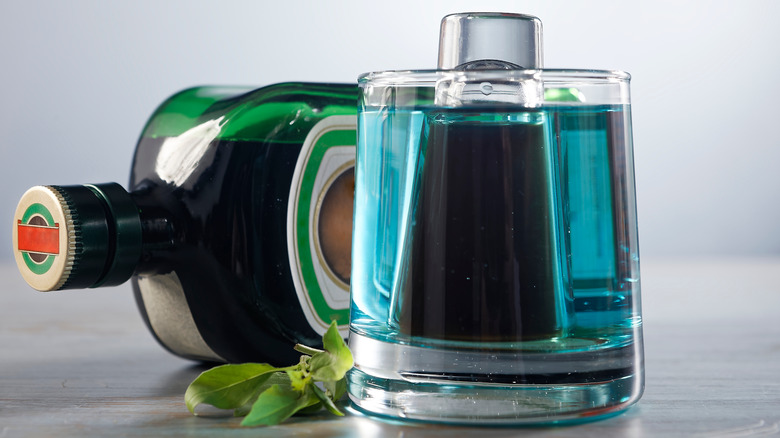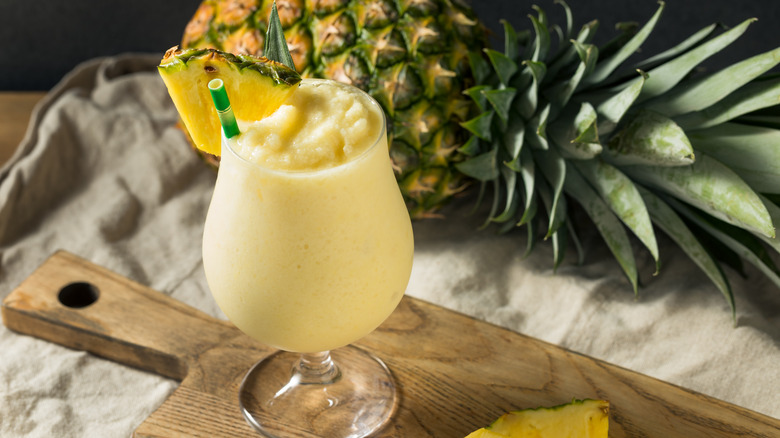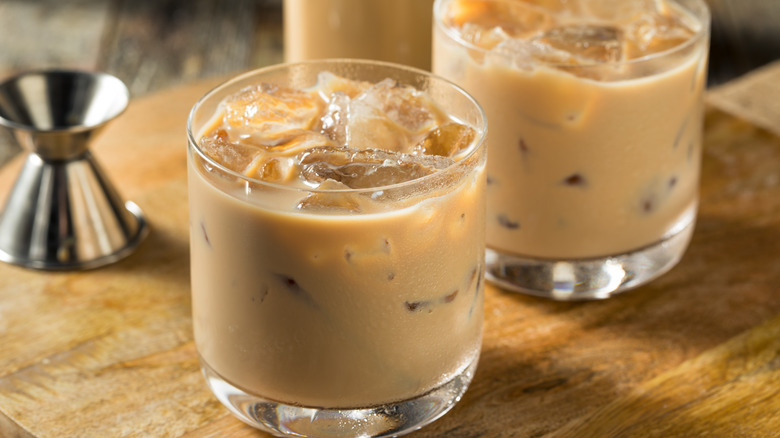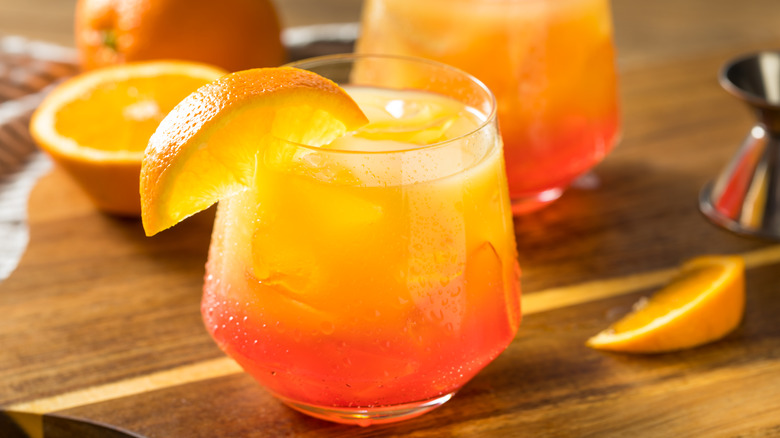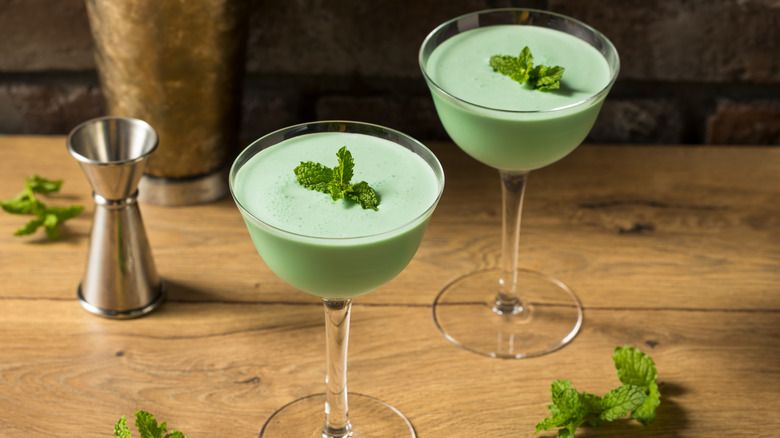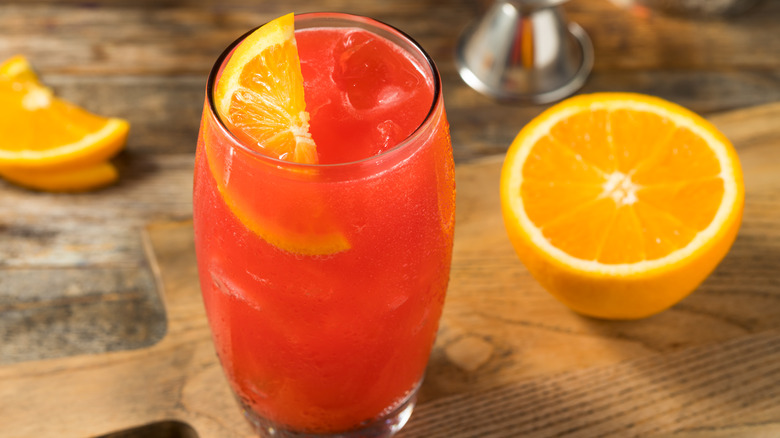Cheap Cocktails You Should Never Order From A Bar
Inexpensive cocktails can be a thing of beauty, especially when you're on a budget. After all, who doesn't love happy hour specials or two-for-one drink promos? But be careful, more often than not, cheap cocktails can also be a major disappointment. You may think you're saving a few bucks, but a bad cheap cocktail—from either a local dive bar or your favorite go-to pub—can be almost undrinkable. Too sweet. Way too fake-tasting. Overpowering and filled with potent fiery house liquor. Or just very badly made, either as a result of your bartender not knowing how to make the drink, or just not caring if it's good or not.
None of these make for an enjoyable night out!
We've already rounded up some of the best inexpensive drinks out there. Now here's the flip side—the worst of the worst. Even when they're priced low, and even when you are trying to save a few bucks, these are the cheap, hangover-inducing, tastebud-assaulting cocktails you should be wary of ordering, no matter how temping they might seem!
Sex on the Beach
Popular for its fruity, easy-to-drink taste, the cocktail known as Sex on the Beach is a weird holdover from the late '80s and '90s.
First created in Florida in the Reagan era, this sweet, tart, bright pink drink typically contains vodka, peach schnapps, orange juice, and cranberry juice. Like many fads, it caught on because of its playful and tropical beachy vibe—the result of those fruity flavors and bright colors—and has never truly gone away since.
Yet while everybody knows about a Sex on the Beach—and might still snicker at the name—few serious cocktail aficionados appreciate the drink or respect it at all. So even when it's sold for bargain basement prices as a special at a bar, it still generally turns out pretty terrible, says Rob Harrah, an instructor and course specialist for the online mixology school A Bar Above.
"This drink is always rushed by bartenders," he explains, "and they typically aren't measuring out any of the ingredients."
Even worse, he adds: "It's almost always overly juicy or overly boozy. Most bartenders assume that if you're ordering a Sex on the Beach, you may not know how to drink—so why would they bother with caring how it comes out."
In general, Harrah says, this is one beach you may want to avoid.
Long Island Iced Tea
The origins of the Long Island Iced Tea are debatable—some say it was a Prohibition-era concoction dreamed up to help folks get drunk quickly when liquor was banned. Others claim the mad scientist mixture originated in a 1970s bartending competition. But there are two things almost everyone who has tried the drink can agree on: It's gonna give you a hangover. And it's never actually as good as you hope it's going to be.
The Long Island Iced tea is actually a major misnomer—it doesn't contain tea at all. Instead, the drink contains a potent mixture of vodka, gin, rum, tequila, triple sec, plus a splash of cola to give it its signature color.
"One day someone got the smart idea to try and combine all the sour drinks, and it tasted terrible," says Charles Oat, owner and master trainer at the Connecticut School of Bartending. "You can add Coca Cola to hide that nastiness, but it's generally terrible."
Harrah agrees.
"This cocktail is a rough one," he says. "It is by design completely off-balance and super boozy. You don't order this to enjoy it. You order it to get drunk. And bartenders know that so they don't even bother trying to make it taste good. They just want to see your face when you drink it. What makes it worse is they use the cheapest stuff they have to make it so it makes its already gnarly booziness all the more harsh."
Blue Hawaiian
Another drink famous for its summer vacation and beach resort vibe, Blue Hawaiians are a favorite among many cocktail enthusiasts around the world, and for good reason. After all, what's not to love? The drink combines exotic rums; fresh, crisp pineapple juice; decadent coconut cream; plus blue curaçao for that distinct flavor and ocean blue color.
In other words, imagine a twist on the iconic piña colada, but with added flavor and color from a quirky tropical liqueur made from bitter oranges and created on the island of Curaçao. Sounds delicious, right? So what's the problem?
Unfortunately, unless you're ordering the drink from a tropical bar right on the beach, you probably aren't going to get a great-tasting cocktail made with high-quality ingredients. Instead, our experts say, your glass is likely to be filled with a bunch of cheap imposter flavors, many of which sit around behind a bar for months because they just aren't used frequently enough to be replaced very often.
"The Blue Hawaiian is one of those cocktails that dumbs down the Tiki cocktail scene in my opinion," says Harrah. "It gets the unfortunate combination of cheap artificial ingredients, questionable spirit combinations, and bartenders rushing to get it away from their bar."
Oat agrees, saying there's nothing inherently wrong with Blue Hawaiians. They just tend to be made really badly in a lot of bars.
"The cocktail has some serious potential," Harrah concludes. "It needs some caring hands."
Appletini
Believed to be the creation of a 1990s-era Los Angeles bartender, the Appletini became a drink of choice—for a minute at least—for the Hollywood A-List. (The name comes from its apple flavor along with its somewhat slight similarity to a classic Martini—basically, they're served in the same glass.)
The drink typically contains vodka, apple schnapps, plus a generous splash of sweet and sour mix. Most variations also include some form of fruit juice such as apple juice or lemon juice to add flavor and complexity.
"Appletinis and other cocktails containing fruit juice can be a bad idea in a bar that doesn't sell a lot of that kind of drink," Oat warns. "The juices can get mixed in the bartending gun and they may have been left sitting in the basement for who knows how long?" he says.
Harrah agrees, saying that in most bars—and especially bars where they are sold cheaply—Appletinis are a mistake.
"First, this cocktail is not an actual martini," he says. "It just comes from an era when adding 'tini' to the name because it was put in a martini glass was all the rage. It was a sad time in cocktail history."
Worse, he adds. "This cocktail is almost always one of two things, either overly sweet or overly sour. I have seen bartenders try to rework this cocktail with some success, but those success stories are a very far departure from the original uber-sweet recipe."
Fuzzy Navel
A drink for novices, or maybe individuals who have just hit drinking age and are getting their first real taste of the world of cocktails, the Fuzzy Navel is a classic cocktail beloved for its sweet and fruity taste.
Created as a variation of the Screwdriver, with peach-flavored schnapps swapped into the drink in place of vodka, this O.J.-infused drink screams summer and can be incredibly refreshing, especially when served over ice in a tall glass and garnished with a slice of peach or a cherry.
However, the problem with the Fuzzy Navel—especially when made and sold up cheaply—is that it's just too simple and bartenders rarely work very hard to make it taste its best.
"The main issue with this cocktail is that it is going to be just thrown together," Harrah warns. "Most two-part cocktails like this are never measured out, so you never know if you're getting a super boozy or super juicy cocktail."
And once again, Oat agrees.
"Fuzzy navels can turn out to be really nasty in a bar sometimes," he says. "A bartender that doesn't care will just pour a bunch of orange juice and schnapps into a glass, shake it up, and hand it to you."
It might be okay, but more often than not, it won't be a drink you are happy with, he says.
Jägerbomb
No drink says "I'm looking to stay out all night and party" more than the ever-popular Jägerbomb. This potent, high-energy favorite for young adults around the world tends to be cheap. And it also tends to be incredibly bad-tasting.
Believed to have been dreamed up by a bartender in Germany in the early 2000s, the cocktail pairs classic Jägermeister (known for its blend of herbs and spices and the resulting distinctive taste) with common energy drinks. To make it, a bartender just has to drop a shot of Jäger into a partially-filled glass containing an energy drink, and voilà ... you've got an instant high-voltage, caffeine-fueled cocktail.
Sadly, Harrah says, because of its simplicity and because of the way it's made, the Jägerbomb is a hopelessly bad cocktail, regardless of its price.
"There is nothing fixable about this cocktail because it's not a cocktail, it's a gimmick," he says. "People should just stay away from cocktails made with energy drinks in the first place."
Aside from the taste, it's also bad for your body, he adds.
"There is no hangover worse than the one you get from drink combinations like this, and yes you will be hungover drinking these because no one drinks them to enjoy them, they drink them to get drunk."
And you're never going to get one that's well made, because "there is no bartender out there that cares how these cocktails come together," he concludes.
Piña Colada
As we've already shown, tropical cocktails tend to be among the biggest losers in bars, made with poor quality, artificial tasting ingredients or blended up using old juices or cheap mixers the bars are anxious to be rid of.
And nowhere does this abuse tend to happen more than with the incredible piña colada. In the right hands, the piña colada can be a delight, combining the best island flavors. You've got crisp sweet rum, indulgent coconut cream, and tart fresh pineapple juice, all blended together into one super-creamy frothy and delicious libation.
But in the wrong hands, watch out!
According to Oat, because of its strong overpowering fruit flavor, piña coladas can be a great place for bars to use up excess cheap house spirits they may have on hand instead of opting for higher quality, better-tasting alcohol.
"It genuinely makes me sad that many people have not had a chance to try this cocktail properly," Harrah adds. "When done right, [the piña colada] is an amazing cocktail and reminds me of why I love Tiki cocktails so much. However, it has been so badly bastardized through the years."
"If you're having a bad [piña colada]," he adds, "that's because your bartender is likely throwing all the ingredients willy-nilly into a blender and hitting frappé. When that happens, any hope of the cocktail being anything more than an overly sweet coconut smoothie ... is gone."
Mudslide
A popular after-dinner cocktail, the Mudslide was inspired by chocolate cakes and ice cream and is meant to be the alcoholic version of those dessert favorites. The drink gets its name from its rich, thick "mud-like" texture and typically contains vodka, coffee liqueur, and Irish cream. Those ingredients are paired with ice and chocolate syrup and everything is then blended together until it reaches a milkshake-like consistency.
Sounds great, right? So what's not to love?
"Any drinks containing dairy can be pretty questionable, especially if a bar does not sell a lot of those drinks," says Oat. "When did they buy the milk? How old is the cream?"
"Watch your bartender's face when you order," he adds. "If you see them thinking 'where the hell's the milk' or 'do we have any cream,' then avoid the drinks."
Harrah has his own reasons for being wary of cheap Mudslides.
"This cocktail is already so creamy!" he warns. "There are so many things that can go wrong here. It can congeal; it can separate and look horrifying. Again, if it's made with low-quality ingredients that are just thrown together, the cocktail won't be good!"
Tequila Sunrise
Known for its bright and colorful appearance, the Tequila Sunrise was created in Mexico in the 1930s and was inspired by the region's colorful dawns when the sun brightly creeps up along those exquisite sandy beaches. In no time, it was a favorite for tourists and locals alike.
As cocktails go, it's a fairly simple one: tequila, orange juice, and grenadine syrup, poured in a specific order to create just the right distinctive red and orange sunrise hues.
With its sweet and tangy flavors, the Tequila Sunrise is the ideal refreshment on a hot day. But it's also the kind of cocktail that can be ruined when sold cheaply by uncaring bartenders looking to churn through their orders quickly.
"The grenadine syrup can be a huge problem in a Tequila Sunrise," Oat warns. "It can be incredibly sweet and overpower your drink. And there's also the question of 'how long has it been there?'"
Some bars don't go through grenadine that quickly, so it's one of those ingredients that can sit around beside the bar for months or years.
This is "another cocktail that is just thrown together typically so it's hard to get a proper one," Harrah told us. "It's also made with cheap ingredients most of the time."
"Combos like this," he cautions, "when they are just thrown together, almost always turn into something you regret ordering."
Grasshopper
This classic cocktail was created in the early 20th century and inspired by the flavors of classic desserts, such as mint chocolate chip ice cream. The grasshopper gets its name from its bright green insect-like color. Although there are a number of regional variations, the drink is typically made with crème de menthe, crème de cacao, and heavy cream. All three ingredients are shaken together with ice and then strained into a glass and garnished with a sprig of mint.
A sweet and indulgent cocktail, the grasshopper has a number of factors going against it, especially if you order a cheap version at your local bar of choice. For starters, crème de menthe and crème de cacao are not overly popular spirits, so if a bar carries them at all, they often tend to be fairly old. Because they have such strong flavors, both also tend to be overly sweet and artificially flavored, leaving them with flavors that can be overpowering at best.
Finally, since the drink also contains heavy cream, there's always the potential the bar won't have it or it too will be very old and on the verge of spoiling.
"The grasshopper is another one of those cocktails that is going to be thrown together with cheap ingredients and little care," says Harrah. "However, it has some awesome potential to be a proper dessert cocktail." You just need to order it in the right bar!
Alabama Slammer
With its vibrant color, bold peach and orange flavor, and deep Southern roots, the Alabama Slammer is in many ways the South's answer to all those fruity rum-based drinks so popular in the Caribbean.
Created in the U.S. in the 1970s, the drink typically contains Southern Comfort, Amaretto, sloe gin, and orange juice. The ingredients are shaken together with ice and then strained into a glass with a resulting flavor so powerful it's supposed to "slam" your tastebuds—hence the name Alabama Slammer.
Despite that flavor punch, the cocktail—and cheap version of the drink in particular—often runs into problems, says Harrah.
It "can be a fun one to drink," he says. "But when the ingredients are just thrown together, [it becomes] a giant booze bomb."
"Truth be told," Harrah adds, "if you're looking for a good cocktail experience, I'd steer from almost all of the cocktails mentioned. Most of them are just not good [drinks] and they come from a moment in the history of cocktails that most mixologists cringe at."
Instead of focusing on drink price, he says, "if you're out and about and find yourself at a bar, take a look around at what everyone is drinking ... If there are a lot of cocktails being enjoyed, chances are you are at a good place for some good cocktails. However, if you see a lot of beer or wine ... it's probably going to be a place you don't want to order a cocktail!"
